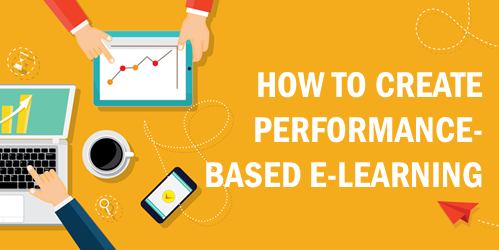How to Create Performance-based E-Learning
Author:
Go to Source

E-learning courses generally fall into one of two buckets: tell people something or show them how to do something. One is all about the information and the other about performance. Both approaches have value.
The reality is that a lot of e-learning is information-based and mostly driven by compliance requirements. Outside of certification of completion, there’s little performance requirement other than compliance to the policies or directives.
For example, generally you don’t have an organization full of sexual harassers and then present a course on sexual harassment and all of a sudden they’re no longer harassing. Instead, the course informs about sexual harassment and the organization’s standard. And the expectation is compliance to that standard. In that sense, the course is information-based because other than compliance, there’s not a performance expectation.
Performance-based E-Learning
On the other side are performance-based courses where the goal is to change behaviors or teach new skills. Those are courses that make a difference (in the sense that one goes from A to B). So how do you know those courses will make a difference?
Here are a few key thoughts to help get there.
- What are the business objectives?
- Why aren’t they meeting those goals today?
- What training do they currently receive (if any)? Why hasn’t it worked?
- How is the course linked to meeting the objectives?
- What do you expect the learners to do after the course that they’re not doing today?
- How will you measure the success of the course?
Performance-based courses are tied to the performance requirements: what are they supposed to do to meet X objective?
Focus on the performance requirement and the actions associated with it. Then build your training around that. In a sense, I like the course to “throw people into the pool.” This gets them to make the types of decisions they’ll make in the real world. If the course is performance-based, design it around those decisions rather than pages of content and policies. All of that content is important, but you can tease it out in the decision-making process and subsequent consequences.
Courses make a difference when they make things different. If you course doesn’t change behaviors or teach new skills, then it’s probably not performance-based. And how you approach the design of it is different than just pushing out information.
Download the fully revised, free 63-page ebook: The Insider’s Guide to Becoming a Rapid E-Learning Pro
Upcoming E-Learning Events
- February 12 & 13 (London). Learning Technologies. Booth J50. Come by to say hello.
- February 14 (Edinburgh). Free user meet-up. RSVP here.
- April 20 & 21 (Brisbane). Articulate Roadshow: Learn more and register here.
- April 23 & 24 (Melbourne). Articulate Roadshow: Learn more and register here.
Free E-Learning Resources
 |
 |
 |
|
Want to learn more? Check out these articles and free resources in the community. |
Here’s a great job board for elearning, instructional design, and training jobs |
Participate in the weekly elearning challenges to sharpen your skills |
 |
 |
 |
|
Get your free PowerPoint templates and free graphics & stock images. |
Lots of cool elearning examples to check out |
Getting Started? This elearning 101 series and the free e-books will help. |
